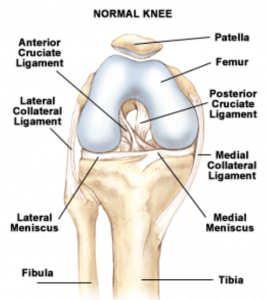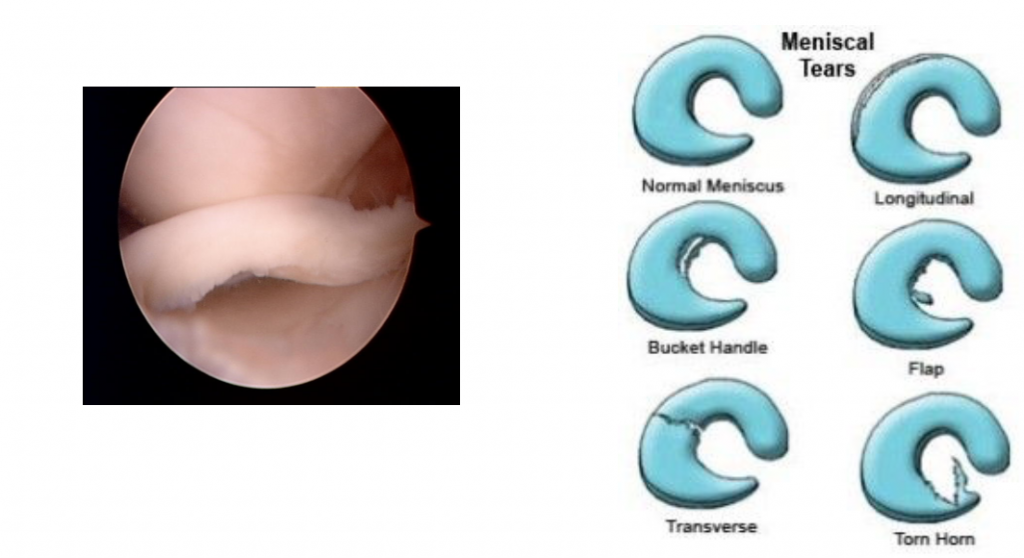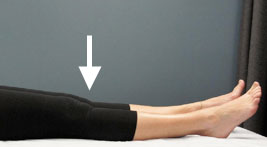Knee Anatomy
Arthroscopy of the Knee
Meniscus Tear
Partial Meniscectomy
Meniscus Repair (Arthroscopic Technique)
Introduction

What is a knee arthroscopy?
An arthroscopy of the knee means to look inside the knee with an arthroscope (camera). An image of the inside structures of the knee are shown on a television monitor. This allows a thorough inspection of the joint to diagnose and treat knee pain. It is generally performed through 2 small incisions (1 cm each) as a day only procedure.
Remember that every knee is unique and recovery time will depend on a number of factors. Not all knees can be made better as damage cannot be reversed. Arthroscopy is a very safe procedure with the potential to treat many common knee disorders with excellent results. Complications are rare but can occur.
What are indications for a knee arthroscopy?
MENISCAL INJURY
This is the most common reason for an arthroscopy. The meniscus is important to the normal functioning of the knee and acts as a shock absorber, or protector of the knee. If the meniscus tears, it can cause a number of symptoms including pain and swelling. The larger the fragment of meniscus removed, the greater the chance of degeneration, or wear, of your knee in the long term.
The younger you are, the more likely Dr Walker will want to repair your meniscus rather than remove it. This cannot be fully assessed until the time of surgery. After a repair, the recovery time is longer than a straightforward arthroscopy and sometimes doesn’t heal.

ARTICULAR CARTILAGE
This is the smooth lining of the joint. This can sometimes be damaged resulting in pain and swelling in the knee, and is often a precursor to arthritis. Arthroscopy can help with this but is less reliable than with meniscal tears. An arthroscopy cannot cure arthritis and hence recovery may be less than complete. Results in these cases may be disappointing with worsening of symptoms.
The older you are, the less likely an arthroscopy is to work and is generally only done if there is catching or locking in the knee.

LOOSE BODIES
Loose bodies are loose pieces of cartilage or bone and can occur from a variety of causes. These generally cause locking and can often be felt floating around the knee.
DIAGNOSIS
Arthroscopies can be useful in diagnosis of ligament tears, injury to bone or cartilage (lining of the joint), biopsies or unexplained pain. Arthroscopy is sometimes performed to confirm or diagnose injuries that are not obvious clinically or on MRI.
PATELLA (KNEECAP) PAIN
Patella pain is usually treated by physiotherapy first as it is a difficult disorder to treat surgically. Occasionally if there are loose fragments of cartilage behind the kneecap, these can be treated with an arthroscopy.
Another treatment of patella pain is to perform a lateral release. This is a procedure where tight structures pulling the kneecap out of place are released. This has a longer recovery period and bleeding into the knee is expected. Supervised physiotherapy will almost certainly be required after this operation.
ASSESSMENT
An arthroscopy can be used to assess the suitability for other surgical procedures (e.g. unicondylar knee replacement or osteotomy).
ARTHRITIS
Arthritis can occasionally be helped by arthroscopy, especially if there are recent mechanical symptoms (i.e. locking, clicking). Arthroscopy will not slow down your progression to arthritis and may in fact speed it up and hence satisfaction for this is not guaranteed. The indications for this condition are limited.
Pre-Operation
- 10 days prior to surgery, cease aspirin and anti-inflammatory medications (e.g. Voltaren, Feldene) as they can cause bleeding.
- 10 days prior to surgery cease any naturopathic or herbal medications as these can also cause bleeding.
- Continue with all other medications unless otherwise specified.
- Notify Dr Walker if you have any abrasions, cuts or pimples around the knee.
- You are advised to stop smoking for as long as possible prior to surgery.
- Please bring any X-rays, MRI scans or other relevant investigations you have had done which may be relevant to your surgery.
Day of Surgery
You will be admitted to the hospital and checked in by a nurse. Your leg will be shaved. The anaesthetist will discuss your past medical history and previous anaesthetics. The operation is usually performed under a light general anaesthetic but the final decision rests with the anaesthetist.
Dr Walker will see you before surgery, generally in the anaesthetic bay, where you can ask him any questions you may have.
Following surgery, you will wake up in recovery with your knee bandaged. Most patients will go home on the day of surgery however some may require an overnight stay. You will require pain killers and may have crutches to go home with if required. You should make arrangements to get home as you will not be able to drive.
Post-Operation
Most knee arthroscopies are performed as a day only procedure. The following are guidelines to assist with your post-operative care until you see Dr Walker.
Bandage: You will either have a bandage or tubigrip on your knee post-surgery. A tubigrip is an elasticated tubular bandage that goes over your foot and around your knee. If you have a bandage, simply remove it the day after surgery, as well as the soft fluffy white material (velband) underneath to expose the dressings, and put on the tubigrip.
Dressings: The dressings are covering up the wounds. Generally, they are clear plastic, called opsites. Leave these on unless they are peeling off, which they do sometimes. These seem to stick to some people’s skin better than others. If they are peeling off and you need to replace them, do so as cleanly as possible i.e. use some sort of antiseptic.Under the dressing there are generally white strips called steri-strips. Try to keep these on. However, again, if they are peeling off you can replace them. If the wound is actively bleeding, you should see your GP or go back to the hospital to change. This is rare.
Showering: You may get the dressing wet in the shower. Do not swim or bath until your review with Dr Walker.
Crutches: Not everyone needs crutches so this will be assessed on an individual basis. Unless Dr Walker specifically advises otherwise you can fully weight bear.
Exercises: Please do the exercises as shown below. Physio is not always required and Dr Walker will discuss this with you at your post-operative visit.
Swelling and ice: Swelling and some bruising is normal. ICING IS VERY IMPORTANT. Ice for roughly 15 minutes every 2 hours until the swelling reduces. Icing varies from a bag of peas to fancy expensive ice machines. Do not ice directly onto the skin as you can get an ice burn. The tubigrip or something of equivalent thickness is good.When sitting place your leg on a stool and when lying place your leg on a pillow.
Pain: Pain is to be expected. The anaesthetist will give you analgesics and/or anti-inflammatories. Take these as required.Remember with opioid drugs, you cannot drive or operate machinery, so try and wean off these.
Concerns:If your temperature rises over 38.5 degrees or if you are unwell (i.e. with rigors or shaking) contact Dr Walker or go to an emergency department. If your wound becomes red please contact Dr Walker.
Follow-up: Your check-up is usually 7-14 days after the surgery. Generally, this appointment will be emailed to you. If for some reason you don’t hear from us please contact Dr Walker’s rooms.
Post-Surgery Knee Exercises
After your operation (knee arthroscopy) the following exercises are necessary to assist in your recovery.
Start these exercises the day after surgery.
To Improve Strength

Raise leg with your knee straight and hold for 6 seconds.
Repeat: 10 times every 2 hours.

Push both knees into the bed and hold for 6 seconds.
Repeat: 10 times every 2 hours.
To Improve Knee Movement

Place your unaffected leg under your affected leg. Gently lower and then raise.
Repeat: 1-2 sessions per day for 2-3 minutes per session.
To Maintain Calf Circulation

To maintain calf circulation, move your foot up and down for 5 minutes every waking hour.
Continue: for 2-3 days or until you are walking comfortably.
If you are experiencing any difficulties with these exercises please contact the clinic for advice.
Risks and Complications
Any surgical procedure has a risk of complications. In arthroscopies complications are rare. You will need to sign a consent form prior to your surgery stating that you understand these risks and wish to go ahead with the surgery. Complications can be related to the anaesthetic or general in nature. Some complications specific to knee arthroscopy are:
- Bleeding
- Oozing
- Infection
- Damage to vessels or nerves
- Reflex Sympathetic Dystrophy
- DVT (or blood clots)
- Ongoing pain
The above list is not exhaustive. For more information on complications:
Knee Arthroscopy Complications
